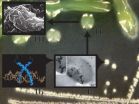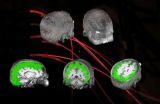(Press-News.org) "Much research has focused on how HIV adapts to antiviral drugs – we wanted to investigate how HIV adapts to us, its human host, over time," says lead author Zabrina Brumme from Simon Fraser University.
In a study published in PLOS Genetics, which traces the evolution of HIV in North America, the Brumme lab and colleagues at the BC Centre for Excellence in HIV/AIDS, Harvard University, the New York Blood Center, and The San Francisco Department of Public Health found evidence that the virus is slowly adapting over time to its human hosts. However, this change is so gradual that it is unlikely to have an impact on vaccine design.
"HIV adapts to the immune response in reproducible ways. In theory, this could be bad news for host immunity – and vaccines - if such mutations were to spread in the population " says Brumme. "Just like transmitted drug resistance can compromise treatment success, transmitted immune escape mutations could erode our ability to naturally fight HIV".
Researchers characterized HIV sequences from patients dating from 1979, the beginning of the North American HIV epidemic, to the modern day. Data analysis – which required the painstaking recovery of viral RNA from historic specimens – was led by a trio of SFU graduate students.
The team reconstructed the epidemic's ancestral ("founder") HIV sequence and from there they assessed the spread of immune escape mutations in the population.
"Overall, our results show that the virus is adapting very slowly in North America" said Brumme. "In parts of the world harder hit by HIV though, rates of adaptation could be higher."
The study ends with a message of hope. Says Brumme: "We already have the tools to curb HIV in the form of treatment – and, we continue to advance towards a vaccine and a cure. Together, we can stop HIV/AIDS before the virus subverts host immunity through population-level adaptation."
INFORMATION:
Link to paper (live upon publication): http://www.plosgenetics.org/doi/pgen.1004295
Citation: Cotton LA, Kuang XT, Le AQ, Carlson JM, Chan B, et al. (2014) Genotypic and Functional Impact of HIV-1 Adaptation to Its Host Population during the North American Epidemic. PLoS Genet 10(4): e1004295. doi:10.1371/journal.pgen.1004295
Contact: zbrumme@sfu.ca
Image description and credit: Brumme lab: clockwise from top right (Zabrina Brumme, Laura Cotton, Xiaomei Kuang, Anh Le)
Photo credit: Greg Ehlers/SFU creative services
Researchers trace HIV adaptation to its human host
2014-04-25
ELSE PRESS RELEASES FROM THIS DATE:
Low-dose natural antimicrobial exacerbates chronic lung infection in cystic fibrosis
2014-04-25
Respiratory failure caused by chronic lung infection with Pseudomonas aeruginosa bacteria is a common cause of death in patients with cystic fibrosis (CF), a genetic disease that is common in individuals of European descent. A study published on April 24th in PLOS Pathogens demonstrates that an antimicrobial peptide produced by human immune cells can promote mutations in the bacterium that make it more lethal.
Daniel Wozniak, from The Ohio State University Wexner Medical Center, USA, and colleagues studied a process called "mucoid conversion", which involves mutations ...
Many patients who could benefit from home dialysis are receiving care in dialysis centers
2014-04-25
Washington, DC (April 24, 2014) — Many kidney failure patients in Australia who could benefit from undergoing dialysis at home are being treated in hospitals and dialysis units, according to a study appearing in an upcoming issue of the Clinical Journal of the American Society of Nephrology (CJASN). This is creating significant costs for healthcare providers and causing unnecessary disruptions to patients' lives.
Home dialysis is more convenient for patients and can provide similar or better care than hemodialysis, which must be done in a clinic. Blair Grace, PhD (Australia ...
Muscle mass linked with physical function and quality of life in dialysis patients
2014-04-25
Washington, DC (April 24, 2014) — Dialysis patients with more muscle mass had better scores on a 6-minute walking test as well as better scores on physical and mental health questionnaires in a study appearing in an upcoming issue of the Clinical Journal of the American Society of Nephrology (CJASN). The findings suggest that physical activity that builds muscle mass may help improve the health and quality of life of dialysis patients.
Physical functional ability is often significantly impaired in patients on maintenance hemodialysis. Srinivasan Beddhu, MD (University ...
Astronomical forensics uncover planetary disks in NASA's Hubble archive
2014-04-25
Astronomers using NASA's Hubble Space Telescope have applied a new image processing technique to obtain near-infrared scattered light photos of five disks observed around young stars in the Mikulski Archive for Space Telescopes database. These disks are telltale evidence for newly formed planets.
If astronomers initially miss something in their review of data, they can make new discoveries by revisiting earlier data with new image processing techniques, thanks to the wealth of information stored in the Hubble data archive. This is what Rémi Soummer, of the Space Telescope ...
Study suggests targeting B cells may help with MS
2014-04-24
PHILADELPHIA – A new study suggests that targeting B cells, which are a type of white blood cell in the immune system, may be associated with reduced disease activity for people with multiple sclerosis (MS). The study is released today and will be presented at the American Academy of Neurology's 66th Annual Meeting in Philadelphia, April 26 to May 3, 2014.
For the study, 231 people with relapsing-remitting MS received either a placebo or one of several low dosages of the drug ofatumumab, which is an anti-B cell antibody, for 24 weeks, with the first 12 weeks making up ...
New guidelines aim to improve care for babies with heart problems in the womb
2014-04-24
Fetal heart experts working with the American Heart Association have developed guidelines to help healthcare providers care for unborn babies with heart problems, as well as their families.
The statement, Diagnosis and Treatment of Fetal Cardiac Disease, is published in the American Heart Association journal, Circulation.
"Congenital heart disease is the most common birth defect that can result in either death or significant health problems in newborn babies," said Mary T. Donofrio, M.D., lead writer of the statement, and director of the Fetal Heart Program and Critical ...
Genetic alterations in shared biological pathways as major risk factor for ASD
2014-04-24
A substantial proportion of risk for developing autism spectrum disorders (ASD), resides in genes that are part of specific, interconnected biological pathways, according to researchers from the Icahn School of Medicine at Mount Sinai, who conducted a broad study of almost 2,500 families in the United States and throughout the world. The study, titled "Convergence of Genes and Cellular Pathways Dysregulated in Autism Spectrum Disorders," was first published online in the American Journal of Human Genetics on April 24.
ASD affects about one percent of the population ...
Controlling brain waves to improve vision
2014-04-24
Have you ever accidently missed a red light or a stop sign? Or have you heard someone mention a visible event that you passed by but totally missed seeing?
"When we have different things competing for our attention, we can only be aware of so much of what we see," said Kyle Mathewson, Beckman Institute Postdoctoral Fellow at the University of Illinois. "For example, when you're driving, you might really be concentrating on obeying traffic signals."
But say there's an unexpected event: an emergency vehicle, a pedestrian, or an animal running into the road—will you actually ...
Computer program could help solve arson cases
2014-04-24
Sifting through the chemical clues left behind by arson is delicate, time-consuming work, but University of Alberta researchers teaming with RCMP scientists in Canada, have found a way to speed the process.
A computer program developed by University of Alberta chemistry professor James Harynuk, his team of graduate and undergraduate researchers and the Royal Canadian Mounted Police National Forensic Laboratory Services, can cut the need for extra levels of human analysis, reducing the waiting time to find out the cause of a deliberately set fire.
That means quicker ...
'Horsing around' reduces stress hormones in youth
2014-04-24
PULLMAN, Wash. – New research from Washington State University reveals how youth who work with horses experience a substantial reduction in stress – and the evidence lies in kids' saliva.
The results are published in the American Psychological Association's Human-Animal Interaction Bulletin this month.
Pendry-80"We were coming at this from a prevention perspective," said Patricia Pendry, a developmental psychologist at WSU who studies how stress "gets under the skin" and the effects of prevention programs on human development. "We are especially interested in optimizing ...


